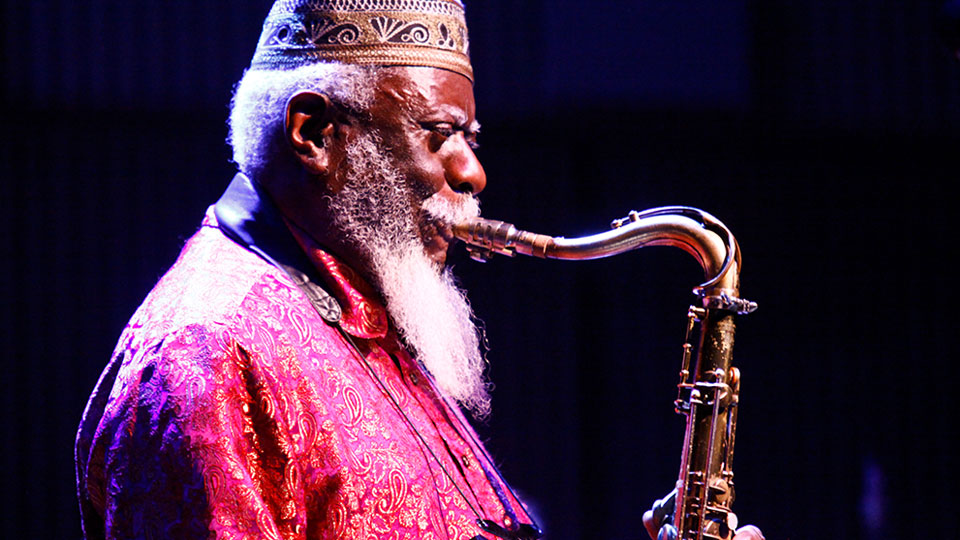Pharoah Sanders In 5 Songs
September 16, 2017 | by Ross Eustis

Pharoah Sanders at SFJAZZ in 2015 (Photo by Tim Charles)
Over his influential career, Pharoah Sanders has shaped his own sonic world that encompasses the primal wails and fierce energy of late John Coltrane and the stomping R&B of his Little Rock youth, Asian modes and Moroccan grooves, while balancing his explosive improvisations with gentle ballads of sublime simplicity. Saxophonist Ornette Coleman once described Pharoah as "probably the best tenor player in the world." Albert Ayler famously said: "Trane was the Father, Pharoah was the Son, I am the Holy Ghost."
Sanders appeared on nine of Coltrane’s Impulse! releases from 1965 to 1967, including the timeless 1965 masterpieces Meditations and Ascension as well as Coltrane’s last studio recording, Expression. He has recorded over 30 albums as a leader and made critical contributions to the work of Alice Coltrane, Don Cherry, and McCoy Tyner.
We explore saxophone legend Pharoah Sanders in five key songs.
1. Pharoah Sanders: “The Creator Has a Master Plan"
A landmark moment in jazz, from his 1969 album Karma, the epic 32-minute-long "The Creator Has A Master Plan" is nothing short of a spiritual journey. Co-written by vocalist Leon Thomas, the song draws from social and political upheavals of the 1960s, and is one of defining recordings of the "spritual jazz" movement.
2. Alice Coltrane: "Journey In Satchidananda"
The title track of Alice Coltrane's fourth studio album, "Journey In Satchidananda" is a meditation on the Indian religious teacher, spiritual master and yoga adept Swami Satchidananda, of whom Coltrane was a disciple of. The Indian tamboura mixed with Coltrane's harping gives the recording a swirling, transcendent feel, while Pharoah Sanders offers melody and improvisation.
3. Pharoah Sanders: "Astral Traveling"
Written by one of Sanders' main collaborators, pianist-keyboardist Lonnie Liston Smith, "Astral Traveling" is an atmospheric gem off 1971's Thembi. Smith recalls the recording session: "I saw this instrument sitting in the corner and I asked the engineer, 'What is that?' He said, 'That’s a Fender Rhodes electric piano.' I didn’t have anything to do, so I started messing with it, checking some of the buttons to see what I could do with different sounds. All of a sudden I started writing a song and everybody ran over and said, 'What is that?' And I said, 'I don’t know, I’m just messing around.' Pharoah said, 'Man, we gotta record that. Whatcha gonna call it?' I’d been studying astral projections and it sounded like we were floating through space so I said let’s call it 'Astral Traveling.' That’s how I got introduced to the electric piano."
4. John Coltrane: "The Father And The Son And The Holy Ghost"
The exploratory intro track off John Coltrane's 1965 avant garde album Meditations (considered by many the spiritual follow-up to A Love Supreme), "The Father And The Son And The Holy Ghost" finds Coltrane and Pharoah improvising together, exploring sounds and multiphonics on the saxophone. Meditations would also mark the last Coltrane recording with Elvin Jones and McCoy Tyner.
5. Pharoah Sanders: "Upper Egypt and Lower Egypt"
"Upper Egypt and Lower Egypt" leads off 1967'sTauhid, the first album Pharoah recorded after John Coltrane passed. The track has two parts. Part one is a searching, rubato segment defined by Sonny Sharrock's electric guitar and non-Western percussion. Part two sees both guitar and percussion falling into an infectious groove, which Pharoah wails over.
